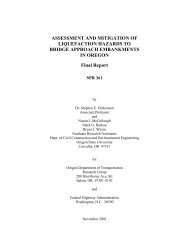Oregon Balance of State HIV/AIDS Housing & Services Systems ...
Oregon Balance of State HIV/AIDS Housing & Services Systems ...
Oregon Balance of State HIV/AIDS Housing & Services Systems ...
You also want an ePaper? Increase the reach of your titles
YUMPU automatically turns print PDFs into web optimized ePapers that Google loves.
46 <strong>Oregon</strong> <strong>HIV</strong>/<strong>AIDS</strong> <strong>Housing</strong> and <strong>Services</strong> <strong>Systems</strong> Integration Plan<br />
grant targeted to serve 55 individuals released from incarceration, through a coordinated effort <strong>of</strong><br />
OHOP, the Department <strong>of</strong> Corrections, and an array <strong>of</strong> other partners.<br />
13. Lack <strong>of</strong> <strong>Housing</strong> Options<br />
Offenders living with <strong>HIV</strong>/<strong>AIDS</strong> face challenges related to their criminal histories as well as their<br />
health diagnoses. They are screened out <strong>of</strong> public and private housing by background checks, and<br />
can find it difficult to transition to mainstream housing assistance programs such as Section 8 from<br />
the OHOP program.<br />
14. Multiple Risk Factors<br />
Poverty, credit problems, substance abuse and mental illness are common among prison inmates,<br />
and may be magnified by their chronic health condition(s). Debts both related and unrelated to<br />
convictions climb while a person is incarcerated and in treatment, which may be required by the<br />
justice system. <strong>Housing</strong> and family situations are disrupted and may be difficult or impossible to reestablish.<br />
Such risk factors translate into high service needs – and gaps in receiving services – when<br />
prisoners return to the community.<br />
Primary Care, Hospitals and Assisted Living<br />
15. Lack <strong>of</strong> Research and Resources for People Living with <strong>HIV</strong>/<strong>AIDS</strong><br />
Steering Committee members identified a need for more assisted living and long-term care options<br />
(including in-home assistance) for people living longer with <strong>HIV</strong>, and those suffering from chronic<br />
diseases like diabetes, which provider observation suggests emerge earlier and more frequently<br />
among people with <strong>HIV</strong> than in the general population. The lack <strong>of</strong> research in the arena <strong>of</strong> chronic<br />
diseases among people living with <strong>HIV</strong>/<strong>AIDS</strong> limits the care a patient has access to. For example,<br />
when screening or preventative measures exist, insurance may not fund those measures for people<br />
with <strong>AIDS</strong> if they lack other risk factors.<br />
16. Additional <strong>Housing</strong> Challenges<br />
Holding housing units and maintaining housing assistance as people cycle in and out <strong>of</strong> assisted<br />
living situations can be difficult, and can require modifications to rules and incur additional<br />
administrative costs. People with chronic diseases may need additional accommodations within<br />
their living units, or may need to live closer to health providers, limiting their ability to move or<br />
choose among housing options. Moreover, traditional assisted-living environments for elderly<br />
people may not be a good fit for younger (middle-aged) people living with <strong>HIV</strong>/<strong>AIDS</strong>. The<br />
difficulty <strong>of</strong> placing clients in assisted living is broader than the <strong>HIV</strong>/<strong>AIDS</strong> population but is a<br />
challenge statewide.<br />
Employment<br />
17. Limited Coordination Among Employment, Service, and <strong>Housing</strong> <strong>Systems</strong><br />
Additional coordination and improved awareness <strong>of</strong> service needs and available resources are<br />
needed between <strong>AIDS</strong> and employment service systems. Typically, employment centers (such as<br />
One Stop Centers established under the federal Workforce Investment Act) are evaluated based on<br />
number <strong>of</strong> successful job placements and similar measures. This may discourage them from serving<br />
clients with the multiple challenges that people living with <strong>HIV</strong>/<strong>AIDS</strong> may have (including gaps in

















